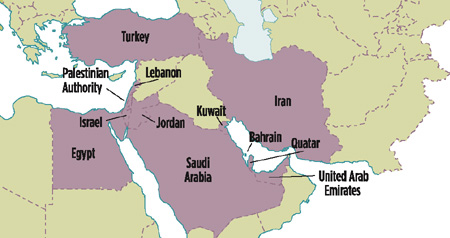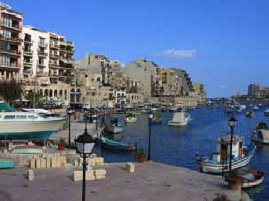|
|
Vol.
28 No. 2
March-April 2006
Frontier Science in the Middle East
by John M. Malin
The conference, Frontiers of Chemical Sciences II: Research and Education in the Middle East, commonly known as Malta II, took place on neutral ground in Valetta, Malta, 5–10 November 2005. This groundbreaking event united scientists from Middle Eastern countries and beyond to discuss shared challenges related to the environment, materials science, medicinal chemistry, nanotechnology, energy, and education.
A key objective of the conference was to find ways for scientists
from conflicting Middle Eastern countries to work together
to achieve common goals. The conference had an outstanding
turnout. Of the 80 participants, all convened by invitation,
56 were from Middle Eastern countries: Bahrain (1), Egypt
(10), Iran (6), Israel (13), Jordan (3), Kuwait (1), Lebanon
(3), Palestinian Authority (11), Qatar (1), Saudi Arabia (3),
Turkey (2), and United Arab Emirates (2).
A multinational organizing committee chaired by Professor
Zafra M. Lerman from Columbia College in Chicago (USA) organized
the event. IUPAC, the American Chemical Society (ACS), the
Royal Society of Chemistry (RSC), and the German Chemical
Society or Gesellschaft Deutscher Chemiker (GDCh) were cosponsoring
organizations. Additional support was provided by the Organization
for the Prohibition of Chemical Weapons (OPCW), the Camille
and Henry Dreyfus Foundation, and a number of public and private
donors.
The conference featured lectures by Nobel laureates Aaron
Ciechanover, Richard Ernst, Yuan T. Lee, Jean-Marie Lehn,
Roald Hoffmann, and F. Sherwood Rowland. Other presenters
included Kurt Begitt, Helmut Ringsdorf, David N. Reinhoudt,
Leiv Sydnes, Michael Graetzel, Peter Atkins, and Simon Campbell.
A special thank you goes to Charles E. Kolb, Ann Nalley, Catherine
Costello, Zafra Lerman, Thomas Spiro, Paul Walter, Stephen
Ritter, and Jeffrey Wade, who did an outstanding job organizing
the conference.
 |
| (Purple) Middle Eastern countries participating in Malta II |
Plenary
Sessions and Workshops
Malta II opened with a welcome reception, dinner,
and a plenary session chaired by Ahmeen Farouk Fahmy of Egypt.
The first plenary address, by Peter Atkins, was titled Galileo's
Finger: The Ten Great Ideas of Science. Atkins presented
a lively tour-de-force of physics, biology, chemistry, and
mathematics in which he lauded the scientific contributions
of Charles Darwin, Francis Bacon, J. Willard Gibbs, Albert
Einstein, Isaac Newton, James Watson, Francis Crick, William
Hale, and Kurt Goedel.
A formal opening ceremony extended a warm welcome to all conference
attendees. Zafra Lerman (conference chair), Paul Walter (master
of ceremonies), Ann Nalley (ACS board representative), Simon
Campbell (RSC president), Leiv Sydnes (IUPAC president), Kurt
Begitt (GDCh representative), and Bijay Chatterjee (OPCW representative)
conducted the opening ceremony.
Alfred Abed Rabbo, Bethlehem University (Palestinian Authority)
chaired a stimulating session in which Yuan T. Lee (Nobel
laureate, Taiwan) spoke on "Energy, Environment and the
Responsibilities of Scientists." Dr. Lee posed a sobering
question: "If all the world lived as we in the developed
countries do, how many Earths would it take to support our
lifestyle?" He inspired attendees by stating that the
twenty-first century could be a great turning point in human
history if we work together to share ideas, solve problems,
develop new technical options, and learn how to live with
limited resources.
Other plenary sessions covered such topics as medicinal chemistry,
environmental air and water quality, nanotechnology, energy
and solar cells, and science education. The workshops provided
an opportunity for many of the Middle Eastern scientists to
share their work with their colleagues while discussing challenges
and areas for future development and research.
In a shared cultural experience, participants attended a concert
of Middle Eastern and classical music at Valetta's Manoel
Theater, now Malta’s national theater. Attendees enjoyed
compositions by Bach, Schumann, Wiesenberg, and Ben-Haim performed
by a trio of Palestinian and Israeli musicians who played
an unusual grouping of violoncello, piano, and oud. The event
was hosted by Maria E. Michel Beyerle, a chemistry professor
and musician from the Technical University of Munich, who
obtained sponsorship from the Aventis Foundation and the Stiftverband
für die Deutsche Wissenschaft.
A poster session, featuring some 40 presentations, mostly
by Middle Eastern scientists, continued throughout the conference.
Discussions and networking sessions took place around the
posters during conference breaks and sometimes extended well
into the evening. On one evening, after some initial coaxing
by Professor Hoffman, participants took part in a lively,
impromptu session of Middle Eastern music and dancing. Previous
tensions that were evident during Malta I were no longer present,
which created a friendlier, more relaxed atmosphere for all.
Progress Since Malta I
One of the sessions covered the outcomes from the first Malta
conference held in December 2003. One of the outcomes is a
collaborative proposal for research on water quality submitted
by Palestinian scientists from the University of Bethlehem
and Israeli chemists from Bra Ilan University and the Weizmann
Institute; that proposal has been funded by an international
agency. Improved communication between Palestinian and Israeli
universities has led to a scientific exchange agreement with
the Weizmann Institute.
At Malta I, Professor Yuan T. Lee offered full fellowships
for three Middle Eastern students to study the use of synchrotron
technologies at the Taiwan synchrotron facility. That first
group of three students has completed its studies, and a second
group will be visiting Taiwan soon.
 |
As
a result of the Malta I conference, a special symposium
on Middle Eastern chemistry was organized at the February
2005 national meeting of the American Association for the
Advancement of Science. The U.S. National Science Foundation
(NSF) also recognized the Malta I conference as an
example of outreach to the broader community by including
the conference in a special poster symposium at the Fall 2005
ACS National Meeting. The NSF has also made a substantial
grant of more than USD 100 000 to Professor Hoffmann to hold
workshops for U.S. and Middle Eastern students. The first
workshop was held in Petra, Jordan, and two more are scheduled
to be held in Egypt and Quatar. It was also recognized that
in August 2004, some 15 scientists from eight countries met
at the IUPAC sponsored International Conference on Chemical
Education, held in Istanbul, Turkey, to discuss Middle East
collaborations.
Success and Encouragement
On the last day of the conference, attendees were given an opportunity to offer feedback on the week's events. Some of their words follow:
"The conference and the efforts are an excellent way
of improving contacts between countries in the region. I hope
this meeting will continue the peace process."
"I hope that the political situation would change
in such a way as to allow scientists to travel and work in
other countries in the region without incurring the disapproval
of their governments and colleagues. I am an optimist and
believe the conference will further this goal."
"The conference could catalyze the creation of an
action group among scientists in the region to work for enhancing
harmony and peaceful coexistence in the area."
"In order to fulfill the real goal of the Malta conference,
priority should be given at future conferences to establishing
a working group for participants, which is supported by the
Nobel laureates and funding agencies."
"Let's keep working to bridge the gap between neighbors
in the Middle East. Create the atmosphere of trust to lead
to a better future for people in this region."
Future Actions
In the final session, recommendations for future actions emerging
from each specific workshop were discussed in the areas of
environmental air and water quality, nanotechnology, energy
and solar cells, chemical education, and medicinal chemistry.
In addition, there was a clear consensus that a Malta
III conference should be held in 2007. Participants suggested
that Malta III could be organized under IUPAC auspices,
perhaps through CHEMRAWN, involving the SESAME (Synchrotron
Light for Experimental Science and Applications in Middle
East) facility in Jordan, or possibly in Cyprus.
Participants
felt that communications should be facilitated by enabling
a Web discussion group. Also, they thought it would be helpful
to identify IUPAC events, such as CHEMRAWN conferences, where
Middle Eastern participants could discuss their progress.
Sources of support for international collaboration with Middle
Eastern scientists need to be identified. J. Malin and Miriam
Waldman volunteered to create a database to facilitate this
process. Attendees also felt it would be helpful to have a
map of Middle Eastern scientific facilities for research projects.
Overall, it was agreed that scientists need to work harder
to help colleagues cross national borders. In addition, participants
suggested that students and younger scientists be invited
to the next Malta conference.
Jordanian
Chemists Join IUPAC
In January 2006, Jordan became a National Adhering Organization
(NAO) of IUPAC through the Jordanian Chemical Society
(JCS). The JCS was established in 1976 with 30 members,
and that number has increased ten-fold since then. Professor
Sultan T. Abu-Orabi, president of Tafila Technical University,
is president of the JCS and also president of the Arab
Union of Chemists. Strengthening relationships is a key
objective of the Society—relationships not only
among Jordanian chemists, but also with the regional and
international chemistry communities. |
Conclusion
After the closing session, attendees enjoyed an excursion
by boat to the historic Maltese city Vittoriosa and were given
one final chance to network and share ideas. During the farewell
gala dinner held at the Palazzo Parisio in Naxxar, Professor
Sultan Abu-Orabi presented the Shield of the Jordanian Chemical
Society to the organizers and representatives of sponsoring
societies. Many discussions took place among Israeli, Arab,
and Persian participants that are expected to lead to fruitful
interactions.
No one could have anticipated the success of the Malta
I and II conferences. Attendees were left with
a great feeling of hope and inspiration as they traveled home
to further their work of using science as a medium to promote
stability in the Middle East.
John M. Malin <[email protected]> is chair of the IUPAC CHEMRAWN committee. He was involved in the organizing committee of Malta I and II.
A longer report is available from the corresponding IUPAC project webpage. www.iupac.org/projects/2004/2004-030-1-020.html
Page
last modified 9 August 2006.
Copyright © 2003-2006 International Union of Pure and
Applied Chemistry.
Questions regarding the website, please contact [email protected]
|